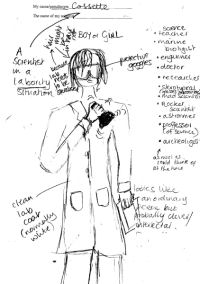
The (In)visible Witnesses Project
Investigating gendered
representations of scientists, technologists, engineers and mathematicians
on UK television
| Introduction |
| Project Outline |
| Further Work |
| Project Dissemination |
| Project Team |
| Contact Us |
| Last Updated November 3, 2008 |
Further work:
 On the basis of the work carried out so far, we are currently exploring ways in which we can extend the project into two related areas.
On the basis of the work carried out so far, we are currently exploring ways in which we can extend the project into two related areas.
-
In our reports we note that the activities carried out by the children and young people, which were designed to encourage them to draw on and develop their media literacy skills, produced some very interesting outcomes and that the participants had engaged with the activity with considerable enthusiasm. We suggest that, given further development and sufficient resources, it should be possible to develop a pack of teaching and learning resources that encourages children and young people’s creativity in developing ideas for future STEM programmes. Such a pack could be used by teachers to facilitate reflection by children and young people on the portrayals of STEM that they witness on television.
In order to move this work forward, we are currently developing teaching and learning resources, including advice for teachers on how these activities can be integrated into existing schemes of work in such a way as to help them meet curriculum requirements and assessment criteria. We are also looking at ways in which details of these resources might be disseminated to teachers and how they, in turn, could evaluate the usefulness of such resources.
-
In our reports we note that, in identifying and analysing STEM content within television programmes, we had employed a broad categorisation of STEM content. As a result of this, we had found much STEM content ‘hidden’ within fictional programming. We also note that this would seem to indicate that STEM is a significant cultural resource that is drawn on by these programme makers. We recommend that a complementary production study is commissioned in order to investigate these issues in more detail, one that particularly focuses on how fictional representations of STEM in children’s television programmes are produced. We suggest that such a study should also involve children and young people, providing valuable insights into any differences between their experiences of engaging with these programmes and the ways in which producers conceptualise their audience.
In order to move this work forward we are looking at the ways in which recent developments in information and communication technologies (for example, online discussions and contributions to weblogs) can be used to capture the experiences of children and young people, and how these experiences can be made accessible to programme-makers in ways that might inform programme development.